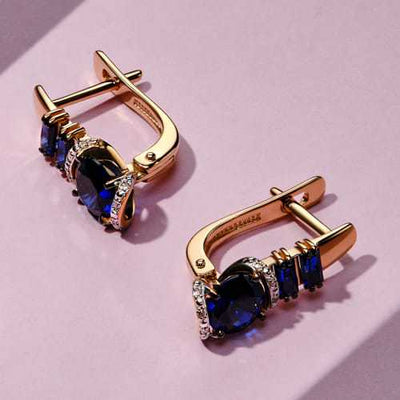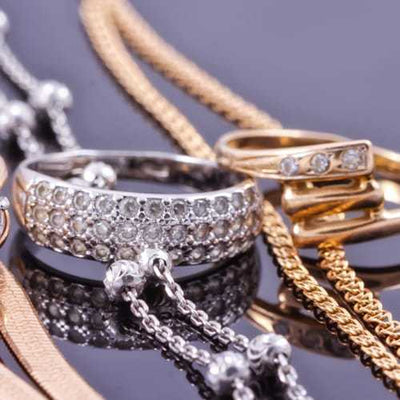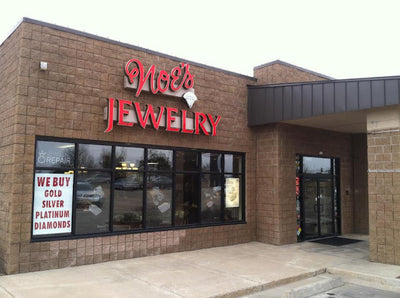Gemstones used for jewelry can come in all sorts of shapes, sizes, and colors. Natural stones from the earth can be quite expensive and even rare, which is why many gemstones are man-made in a lab. Many people may wonder if lab-created gemstones are real, and the answer to that question is yes—they just have a different origin story from that of a natural stone.
So, what exactly is the difference between natural and lab-created gemstones? Let’s find out!
What Are Natural Gemstones?
Natural gemstones are minerals that have been cut and polished to be used in jewelry or other decorative objects. These stones are mined, meaning they originate from beneath the surface of the earth. Some of the most popular natural gemstones include diamonds, emeralds, pearls, and sapphires, among many others.
Natural stones are formed in multiple ways, including within the earth’s mantle, along a tectonic plate subduction zone, at asteroid impact sites, and even up in space. After the stones are found in locations around the world, they are then cut and polished by skilled artisans and used by jewelers to make timeless pieces, like rings, earrings, and pendants.
Although more expensive, purchasing a natural gemstone is a great investment since they appreciate in value over time. If you’re interested in purchasing a natural gemstone, it’s best to do as much research as possible. Not all natural stones are created equally, and some can be more valuable than others. Working with a reputable jewelry store can ensure you are getting the best quality gemstones for your money.
What Are Lab-Created Gemstones?
Lab-created stones are made in a lab with a similar process as the one that occurs beneath the earth for natural stones. The only difference is that these stones cost much less to make and take less time. Lab-created gemstones may also be referred to as “synthetic,” “artificial,” “man-made,” or “lab-grown”; however, these stones are just as genuine in their characteristics as mined ones.
During the creation process, mineral crystals that make up natural gemstones are synthesized, resulting in a stone that can have the same physical, chemical, and optical properties as its natural counterpart. This can happen in one of two ways:
- High Pressure-High Temperature (HPHT): A gemstone seed is placed in carbon and then exposed to extreme pressure and high temperatures that imitate what’s found below the earth’s surface. Once the carbon melts and cools, a crystallized stone is left behind.
- Chemical Vapor Deposition (CVD): A slice of gemstone seed is heated to extreme temperatures in a chamber with gas, such as methane. Then, tiny layers of crystal slowly “grow” onto the seed, eventually forming a full stone.
Are lab-created gemstones real? Absolutely! Lab-created stones have the same properties as natural gemstones and only differ in how they are made. Many people shopping for engagement rings may opt for a man-made gemstone, like a lab-created diamond, as a more affordable option, since these stones are not as expensive as mined ones.
What Are the Differences Between Natural and Lab-Created Gems?
The main difference between lab-created gemstones and natural gemstones is how they are made. Lab-created gemstones are made in a controlled environment using advanced technology. This allows for more consistent quality and color than what can be found in nature. Natural gemstones are created by nature over millions of years, subject to imperfections caused by the earth’s formation processes.
Differentiating natural and lab-created gemstones can be tricky, but some key characteristics can help you tell them apart. Here is a closer look at the differences between natural and lab-created gemstones:
- Appearance: Lab-created gemstones are often made of cheaper materials and have a more uniform appearance. Natural gemstones, on the other hand, are formed over time by nature and have unique variations in color, clarity, and cut. Keep in mind, however, that both types of stones are graded using the four C’s.
- Cost: Because natural gemstones are rarer and must be mined from the earth, they are more expensive. In contrast, lab-created gemstones typically cost less than natural gemstones because they are mass-produced.
- Durability: Lab-created gemstones are often made of stronger materials and have a higher resistance to wear and tear. Natural gemstones can be more fragile and may be susceptible to damage, depending on the gem.
- Value: Natural gemstones hold more value because of their formation process and the fact that they are rarer. Because of this, they will also increase in value as time passes. Alternatively, lab-created gemstones usually hold less value. While this makes them more affordable to purchase initially, you would receive less return on your investment if you ever decided to sell the gem.
Are Imitation or Simulated Gemstones the Same as Lab-Created Gemstones?
Many people believe that imitation, or simulated, gemstones are the same as lab-created ones. However, this is not true; there are actually some key differences between these two types of stones.
Simulated gemstones are usually made from cheaper materials, such as glass, plastic, or another stone than what it claims to be. While they are intended to look like natural gems, their composition is not the same and does not follow the same creation process as what’s found under the surface of the earth.
Imitation or simulated gemstones are often used in costume jewelry or for other decorative purposes, and they are also not as valuable as lab-created gems. This is because they are not as rare, nor are they as durable. Lab-created gemstones are real stones, will last longer, and will retain their value better over time.
Some jewelers or other vendors may be honest about selling simulated stones, but buyers beware—while imitation stones are not meant to be deceptive, certain sellers may not disclose this information in an attempt to mislead you. That’s why it’s always wise to do your research about the stones you are buying and where you are buying from.
Whether you’re looking for natural stones or lab-created gems, Noe’s Jewelry in Raymore, Missouri, is here for you. Visit our store today to learn more or contact us at 816-322-7227.






